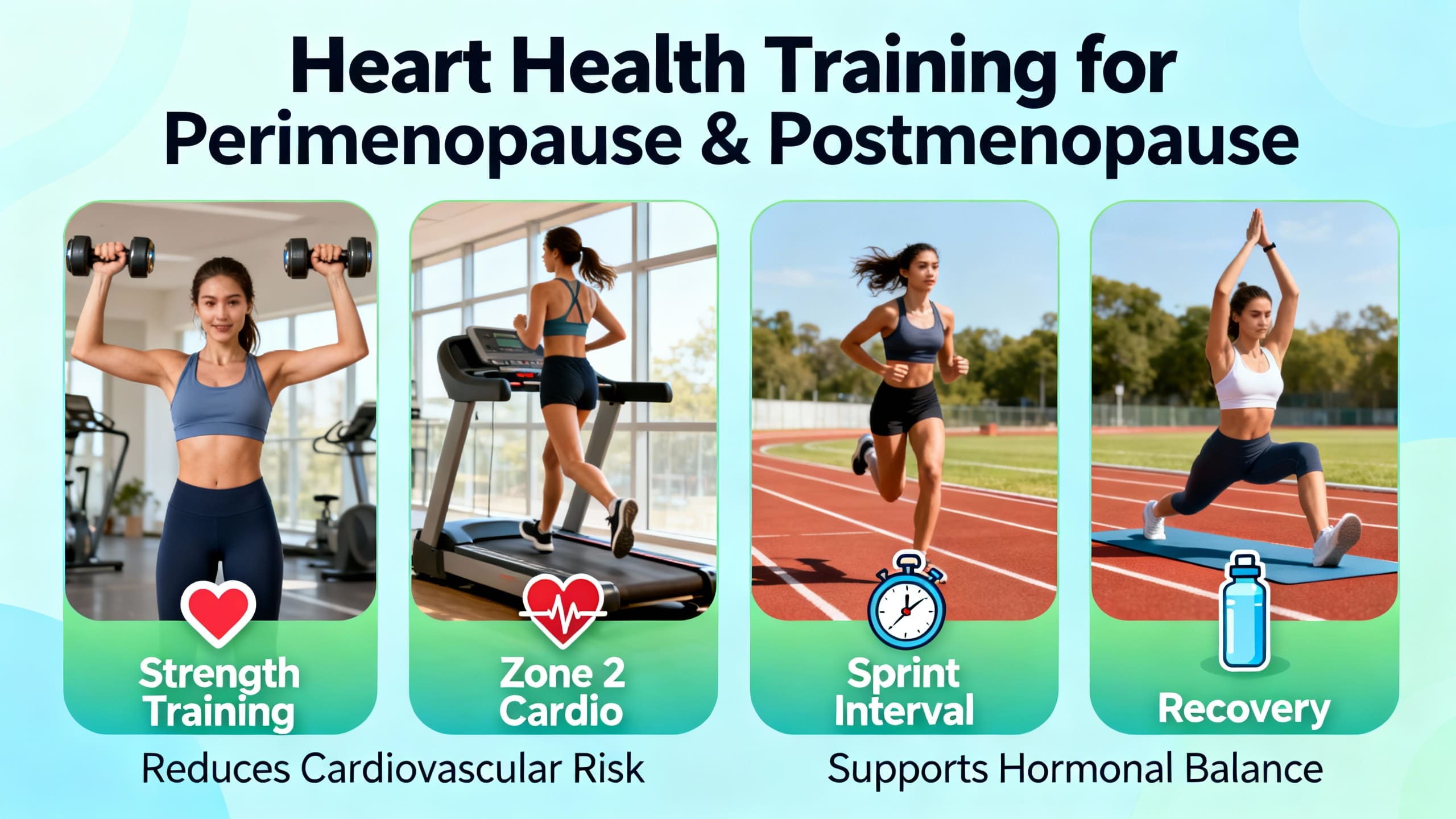Introduction
Navigating perimenopause to postmenopause presents unique challenges for women, especially when prioritizing heart health and striving for an optimal heart. During these pivotal life stages, women’s health is intricately influenced by hormonal fluctuations that impact cardiovascular function, physical performance, and recovery. Tailoring training—focusing on the integration of strength, Zone 2 cardio, sprint work, and strategic recovery—offers compelling pathways to support heart health and improve cardiovascular outcomes. This article explores how synchronizing exercise modalities with hormonal changes can be a game-changer for women’s heart health during perimenopause and beyond.
What is Match Training Phases to Hormonal Changes—Strength, Zone 2, and Sprint Work with Recovery Tactics?
Matching training phases to hormonal changes means aligning different forms of exercise, such as strength training, steady-state Zone 2 cardio, high-intensity sprint intervals, and recovery strategies, with the natural hormone variations women experience from perimenopause through postmenopause. Estrogen and progesterone levels influence many aspects of cardiovascular health, including blood pressure regulation, cholesterol balance, and vascular function (Braun & Miller, 2022). By optimizing training around these hormonal shifts, women can achieve improved heart health and support an optimal heart, reducing their risk of heart disease as they age (Faubion et al., 2015).
Benefits and Outcomes in Heart Disease
Research shows that adapting cardiometabolic exercise and strength conditioning to the perimenopausal and postmenopausal phases yields key benefits for heart health. Regular strength training has been linked to favourable cholesterol profiles and reduced arterial plaque (Westcott, 2012). Zone 2 cardio—moderate, steady-state aerobic work—improves vascular health, aids in blood pressure management, and boosts the efficiency of the heart muscle (Seals et al., 2019). Sprint intervals, or high-intensity workouts, elevate cardiovascular fitness, enhance insulin sensitivity, and cut systemic inflammation (Gibala et al., 2012). When paired with adequate recovery (rest, sleep, and active recovery practices), these training modes optimize cardiac adaptation, further reducing heart disease risk (Thyfault & Booth, 2011).
Research Insights
Recent studies emphasize the importance of phase-specific training for heart health in women navigating menopause. A 2022 review underscores that strength and aerobic training reduce cardiovascular risk factors and symptoms common in midlife women, such as hypertensive spikes and lipid imbalances (Braun & Miller, 2022). Human trials of moderate-intensity (Zone 2) exercise reveal improvements in endothelial function and arterial flexibility in postmenopausal populations (Seals et al., 2019). High-intensity interval training (HIIT), incorporating sprints, is noted for rapid gains in cardiorespiratory health—even when total exercise volume is low (Gibala et al., 2012). Importantly, clinical guidelines recommend incorporating recovery strategies to mitigate hormonal stressors and protect heart health as hormonal support wanes (Faubion et al., 2015).
Practical Applications
For optimal heart health, women in perimenopause and postmenopause should aim for a balanced training regimen:
- Strength Training: 2–3 sessions per week, focusing on major muscle groups, to maintain muscle mass, metabolic health, and arterial flexibility (Westcott, 2012).
- Zone 2 Cardio: 150 minutes per week of moderate-intensity aerobic exercise (e.g., brisk walking, cycling) for heart health and endurance (Seals et al., 2019).
- Sprint Work/HIIT: One or two short sessions per week—such as 4–6 30-second sprints with recovery—to enhance heart rate variability and vascular response (Gibala et al., 2012).
- Recovery: Prioritize 7–9 hours of sleep, active recovery (such as yoga or stretching), and regular rest days to facilitate hormonal and cardiovascular reset (Thyfault & Booth, 2011).
Those with underlying conditions should consult healthcare professionals to tailor the routines for individual heart health needs.
Risks & Limitations
While phase-matched training offers cardiovascular benefits, there are important considerations. The drop in estrogen during menopause can initially increase cardiovascular risk, making progressive exercise intensity and volume crucial (Braun & Miller, 2022). Overtraining without sufficient recovery may exacerbate heart strain and hormonal imbalance. Some women might have undiagnosed heart conditions or joint limitations, so medical clearance is advised before beginning intensive regimens (Faubion et al., 2015). More long-term, large-scale studies are needed to fine-tune protocols for diverse populations.
Key Takeaways
- Tailored cardio and strength programs support heart health in perimenopausal and postmenopausal women.
- Zone 2 aerobic work and strength training optimize cardiovascular risk markers for an optimal heart.
- Sprint workouts and proper recovery enhance vascular health and resilience.
- Clinical guidelines recommend individualized, phase-matched approaches for sustaining an optimal heart.
- Consulting healthcare professionals ensures exercise programs are safe and effective.
Frequently Asked Questions
Q1: Why is heart health a bigger concern during perimenopause and postmenopause?
A: The decline in estrogen increases the risk for cardiovascular disease, making proactive heart health strategies crucial during these life stages (Braun & Miller, 2022).
Q2: How does Zone 2 cardio support an optimal heart in midlife women?
A: Zone 2 cardio improves blood vessel flexibility, endurance, and blood pressure regulation, key for optimal heart outcomes (Seals et al., 2019).
Q3: Can sprint training be safe for all women in menopause?
A: Sprint intervals can be beneficial, but women should start gradually and consult with healthcare providers, especially if there are heart risk factors (Gibala et al., 2012).
Q4: How important is recovery for heart health in this population?
A: Prioritizing rest and sleep reduces stress on the cardiovascular system and is strongly recommended by clinical guidelines (Thyfault & Booth, 2011).
Suggested Links
- American Heart Association: Menopause and Heart Disease
- NIH: Menopause and Heart Health
- PubMed: Exercise Interventions for Midlife Women’s Heart Health
Conclusion
Customizing training phases to work with hormonal changes is a proven strategy for safeguarding heart health and achieving an optimal heart during perimenopause and postmenopause. By integrating strength, Zone 2 cardio, sprint intervals, and recovery, women can proactively reduce cardiovascular risk, boost overall well-being, and thrive through the menopause journey. Take the first step toward heart-smart living—consult your healthcare provider and build a fitness plan that keeps your heart strong for years to come.



